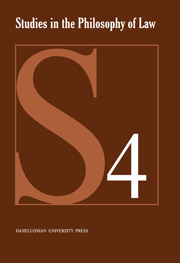Book contents
- Frontmatter
- Contents
- Preface
- Six Causes of the Dispute over Legal Bioethics
- Bioethics and Legal Philosophy
- The Outline of the Subject of Biojurisprudence
- Law and Biotechnology
- The Ethical Significance of Evolution
- Human Nature after Darwin
- The Notion of the Person in Bioethical Debates
- The Roots of Normativity. From Neuroscience to Legal Theory
- Why No One Should Ever Win the Nobel Prize: Neurolaw, Reward and Punishment
- Is There Anybody Who Really Wants to Live Forever? The Significance of Mortality
- The Slippery Slope Arguments Against the Legalization of Physician-Assisted Suicide
- Ethical Problems of Hematopoietic Stem Cells Transplantation
- Notes about the Authors
Bioethics and Legal Philosophy
Published online by Cambridge University Press: 05 September 2014
- Frontmatter
- Contents
- Preface
- Six Causes of the Dispute over Legal Bioethics
- Bioethics and Legal Philosophy
- The Outline of the Subject of Biojurisprudence
- Law and Biotechnology
- The Ethical Significance of Evolution
- Human Nature after Darwin
- The Notion of the Person in Bioethical Debates
- The Roots of Normativity. From Neuroscience to Legal Theory
- Why No One Should Ever Win the Nobel Prize: Neurolaw, Reward and Punishment
- Is There Anybody Who Really Wants to Live Forever? The Significance of Mortality
- The Slippery Slope Arguments Against the Legalization of Physician-Assisted Suicide
- Ethical Problems of Hematopoietic Stem Cells Transplantation
- Notes about the Authors
Summary
The origin and development of bioethics
Bioethics has been developing at a galloping pace since the early 1970s, expanding its scope over a wider and wider range of subject matter, in parallel with the progress of scientific research and applications.
It is worth recalling that the 1960s and 1970s were a time in which technological innovation enabled medicine to make great strides. A short list will suffice: in 1965 the first heart transplant was conducted; in 1972 came recombinant DNA technology, making it possible to modify the structure of DNA; in the 1970s, respirators came into use, making it possible to give life support to critically injured victims of serious accidents; and in 1978 Louise Brown was born, the first test-tube baby. Hand in hand with this innovation, new situations arose which have caused us to rethink our traditional categories of life and death.
The dominant moral philosophy had been analytical, mostly concerned with the logical clarification of concepts and meaning. However, this line of thinking progressively gave way to an emphasis on questions of substance and content, with a discussion spanning across a range of issues and problems. This ranged from the general (how to frame a just society, what criteria should public policy be guided by) to the particular, where human and animal life and nature became subjects of investigation, with the first forms of applied ethics – thus bioethics was born, alongside animal and environmental ethics.
- Type
- Chapter
- Information
- Studies in the Philosophy of LawLegal Philosophy and the Challenger of Biosciences, pp. 19 - 26Publisher: Jagiellonian University PressPrint publication year: 2010



